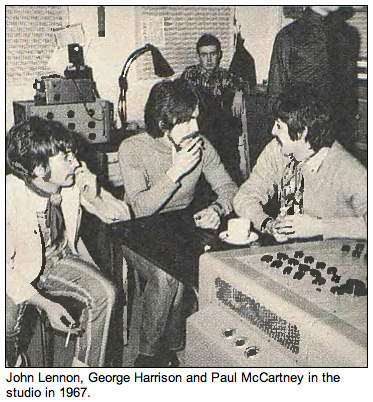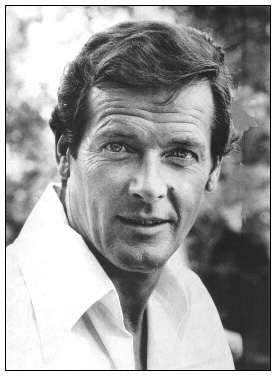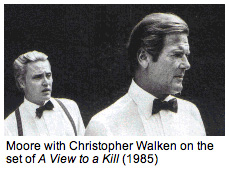![]()
| Sgt. Pepper's Lonely Hearts Club Band Turns 50 |
|
![]()
Celebrating the Beatles' masterpiece.
By Eric Renner Brown in Entertainment Weekly

![]() n June 1, 1967, John, Paul, George, and Ringo changed the world when they released Sgt. Pepper's Lonely Hearts Club Band, one of the greatest albums of all time. Now, for its 50th anniversary, the band's label is putting out a massive reissue -- featuring two discs of outtakes -- that offers an unprecedented look at the making of a masterpiece. Giles Martin, the son of late Beatles producer George Martin who helped oversee the effort, and Jann Haworth, codesigner of the iconic album art, take us behind the scenes of the Fab Four's finest.
n June 1, 1967, John, Paul, George, and Ringo changed the world when they released Sgt. Pepper's Lonely Hearts Club Band, one of the greatest albums of all time. Now, for its 50th anniversary, the band's label is putting out a massive reissue -- featuring two discs of outtakes -- that offers an unprecedented look at the making of a masterpiece. Giles Martin, the son of late Beatles producer George Martin who helped oversee the effort, and Jann Haworth, codesigner of the iconic album art, take us behind the scenes of the Fab Four's finest.
PAUL AND RINGO WERE HEAVILY INVOLVED IN THE REISSUE
 For this edition, Martin created an immersive stereo remix of Sgt. Pepper's to rival the 2009 remaster. But he wasn't on his own with such a Herculean task. "Paul has to be happy, and Ringo has to be happy," says Martin. "I had a huge safety net, and the safety net is them."
For this edition, Martin created an immersive stereo remix of Sgt. Pepper's to rival the 2009 remaster. But he wasn't on his own with such a Herculean task. "Paul has to be happy, and Ringo has to be happy," says Martin. "I had a huge safety net, and the safety net is them."
EVEN THE WORLD'S BEST BAND MADE GOOFS SOMETIMES
Sure, every note of Sgt. Pepper's is perfect -- but that's because some weird ideas were cut, Martin reveals. One take of "A Day in the Life," for instance, found the band humming the song's final chord in unison. "I was like, 'Oh my God, were they seriously going to do this?'" Martin says. "What's reassuring is that even on an album full of good ideas, they came up with bad ones -- which is heartening for us mere mortals. Their willingness to try things shows how they got to where they got."
PAUL AND JOHN WERE A SYMBIOTIC UNIT IN THE STUDIO
While their creative partnership would be strained after Sgt. Pepper's -- the Beatles announced their breakup just three years later -- the pair were still in tandem for these sessions. "You hear them giving each other guidance," says Martin about the outtakes. "There's a bit where 'Lucy in the Sky With Diamonds' ends and Paul goes through how John should be singing on the verses: 'Don't go cell-oh-phane flowers, go cello-phane flowers.' The album is the sum of their parts."
SGT. PEPPER'S WAS GEORGE MARTIN'S FAVORITE BEATLES LP
The late producer and arranger worked on just about every Beatles recording. And, to him, nothing compared to Sgt. Pepper's. "It was my dad's favorite Beatles and the one that he was the most proud of," Giles Martin says. "It was the peak of the happiest time."
"STRAWBERRY FIELDS FOREVER" AND "PENNY LANE" COULD'VE ENDED UP ON THE ALBUM
 The Beatles began these sessions by recording "Strawberry Fields Forever" and "Penny Lane," but those tracks didn't make it onto the LP and were instead released as one 7-inch single. While outtakes of both songs are featured on the reissue, George Martin had hoped to include them on the original release. "For my dad, 'Penny Lane' and 'Strawberry Fields' were the catalyst for the making of Sgt. Pepper's," says his son. "It was a sea change for the way things were recorded. They wanted to paint pictures with sound and create a world that they couldn't perform live. My father said he regretted them not being on the album."
The Beatles began these sessions by recording "Strawberry Fields Forever" and "Penny Lane," but those tracks didn't make it onto the LP and were instead released as one 7-inch single. While outtakes of both songs are featured on the reissue, George Martin had hoped to include them on the original release. "For my dad, 'Penny Lane' and 'Strawberry Fields' were the catalyst for the making of Sgt. Pepper's," says his son. "It was a sea change for the way things were recorded. They wanted to paint pictures with sound and create a world that they couldn't perform live. My father said he regretted them not being on the album."
FAMOUS FIGURES WERE CUT FROM THE COVER ART
The Beatles tapped pop artists Peter Blake and Jann Haworth to help create the iconic image, which showed the band surrounded by cutouts of 58 historical figures. John had lobbied to include Hitler, Ghandi, and Jesus -- but those were nixed. "It would've been a disaster [if Hitler were included]," says Haworth. "He was not infallible, our John." As for the celebrities who were living at the time, the Beatles had to secure their permission. "Mae West said, 'What would I be doing in a lonely hearts club band?'" recalls Haworth. "So the Beatles had to write a letter [explaining the idea], and then she said, 'Fine.'"
GRAMMARIANS, TAKE NOTE: THERE IS AN APOSTROPHE
It's a question long debated by Beatlemaniacs: Is it Sgt. Peppers or Sgt. Pepper's? The cover art's bass drum famously omitted the apostrophe, but Haworth is setting the record straight. "It was a mistake. There should have been an apostrophe. Sgt. Pepper is the man -- and the band belongs to him." ![]()
|
| Roger Moore, 1927-2017 |
|
![]()
He wasn't the original James Bond, but no one had more fun playing 007.
By Chris Nashawaty in Entertainment Weekly

![]() ean Connery may have originated the James Bond role, but Roger Moore, who died of cancer on May 23 at the age of 89, reinterpreted it with his light touch. Over the span of 12 years, he played 007 in seven films, more than any other actor. From 1973's Live and Let Die to 1985's A View to a Kill, he triumphed over Caribbean voodoo, outskied Aryans on Alpine motorcycles, and outwitted baddies with golden guns and superfluous nipples. He drove a Lotus sports car underwater, defused a nuclear warhead (while wearing a clown suit!), and he always got the girl. Always.
ean Connery may have originated the James Bond role, but Roger Moore, who died of cancer on May 23 at the age of 89, reinterpreted it with his light touch. Over the span of 12 years, he played 007 in seven films, more than any other actor. From 1973's Live and Let Die to 1985's A View to a Kill, he triumphed over Caribbean voodoo, outskied Aryans on Alpine motorcycles, and outwitted baddies with golden guns and superfluous nipples. He drove a Lotus sports car underwater, defused a nuclear warhead (while wearing a clown suit!), and he always got the girl. Always.
Moore was born in South London, the only child of a police officer and a homemaker. It was a short bus ride away from M16 headquarters, but the world described in the pages of Ian Fleming's novels might as well have been in another galaxy.
 Moore's posh diction and demeanor had always been an act -- a pose that hardened into a persona over the years. After studying at the Royal Academy of Dramatic Art and serving as a second lieutenant during the final year of World War II, he knocked around the British stage before lighting out for Hollywood in 1953.
Moore's posh diction and demeanor had always been an act -- a pose that hardened into a persona over the years. After studying at the Royal Academy of Dramatic Art and serving as a second lieutenant during the final year of World War II, he knocked around the British stage before lighting out for Hollywood in 1953.
He landed a contract at MGM and racked up a string of small-screen appearances -- including replacing James Garner on the fourth season of Maverick -- before being cast as the suave Simon Templar in the hit television series The Saint (1962-69).
Moore was Bond producer Albert "Cubby" Broccoli's first choice to play 007 in 1962's franchise kickoff, Dr. No, but the actor's Saint contract stood in the way. When Connery let the role in the early '70s, Broccoli made the offer again. Just like that, the working-class kid from South London became the embodiment of globe-trotting luxury and license-to-kill fantasy.
There were other roles for Moore post-Bond. In fact, a couple of very good ones. But none fit him with the same bespoke tailoring as 007's dinner jacket. Plus, he was content in his later years to volunteer as a UNICEF goodwill ambassador and spend his summers in Monaco and winters in Switzerland with his fourth wife, Kristina.
For some actors, being so indelibly linked to one character can feel like a prison, albeit a gilded one. Not Moore. He always considered himself incredibly lucky to have found Bond when he did. To ask for anything more, he said, would have seemed ungrateful and unbecoming.
Beyond 007, the actor built an impressive résumé.

THE SAINT (1962-69) - Moore's first taste of real fame came on TV, playing a suave thief who steals from the rich to give to himself -- a double-0 dress rehearsal of sorts.
THE MAN WHO HAUNTED HIMSELF (1970) - After a near-death incident, Harold Pelham (Moore) wakes up with a doppelgänger. Or is he just going mad? Moore's trickiest and most difficult role.
THE PERSUADERS! (1971-72) - Moore returned to TV to play a British blue blood who solves unsolvable crimes with his street-smart New York partner (Tony Curtis).
THE WILD GEESE (1978) - A band of hard-charging mercenaries (including Richard Burton and Richard Harris) turn this postcolonial African adventure into a rollicking testosterone workout.
SPICE WORLD (1997) - Moore sends up his celluloid legacy as the eccentric Blofeldesque head of the Spice Girls' record label. A winking coda to his career.
In defense of, yes, Roger Moore.
 By Nick Sullivan in Esquire
By Nick Sullivan in Esquire
![]() od bless Sir Roger Moore, Bond's snappiest dresser, utterer of the glibbest lines in cinema history, delivered in that posh, lockjawed basso profundo that echoed all the way back to the Home Counties. But man, those flares...
od bless Sir Roger Moore, Bond's snappiest dresser, utterer of the glibbest lines in cinema history, delivered in that posh, lockjawed basso profundo that echoed all the way back to the Home Counties. But man, those flares...
All right, you cannot blame Rog for the '70s. It was hardly his fault that his 12-year-tenure with the Bond franchise (1973-85) coincided with the decade that style forgot (or so sieve-minded fashion people like to think). And yet I've begun to wonder if that heady time was not, in fact, men's wear's golden age -- or one of them, anyway -- and Sir Roger its tailor-made on-screen champion.
Moore's style as Bond was a relatively conservative take on the prevailing style of the early '70s, reflecting as it did 007's character and his establishment background. But it was certainly Moore's own style, too, created and curated by him in conjunction with his bespoke tailor: the late, great Dougie Hayward on Mayfair's Mount Street. Hayward alumni include Michael Caine, Richard Burton, and John le Carré (who immortalized Hayward as the eponymous Tailor of Panama). The chesty, full-skirted blazers and roped shoulders were in the proper Savile Row tradition, but they had a bit of an edge that gave Hayward his reputation and following. So they were also entirely appropriate for a peripatetic military man in civvies such as Bond. Flared safari suits were less expected. Yet Moore's moment came in easier times than Connery's -- his predecessor's '60s world was a harder, grimier, grittier Britain still living with the aftermath of World War II. The '70s, by contrast -- if you don't count Vietnam, Baader-Meinhof, and the oil crisis -- were fun. Moore still had his fair share of megalomaniacs, plutocratic nutters, and crime lords to deal with, but unlike Connery and his roughhouse tactics, his Bond could dispatch them all with a karate chop and a raised eyebrow. And vital to that debonair image (a forgotten quality) were clothes that, though extreme to us now, were always immaculate and worn with panache. ![]()
![]() Reader's Comments
Reader's Comments
No comments so far, be the first to comment.

